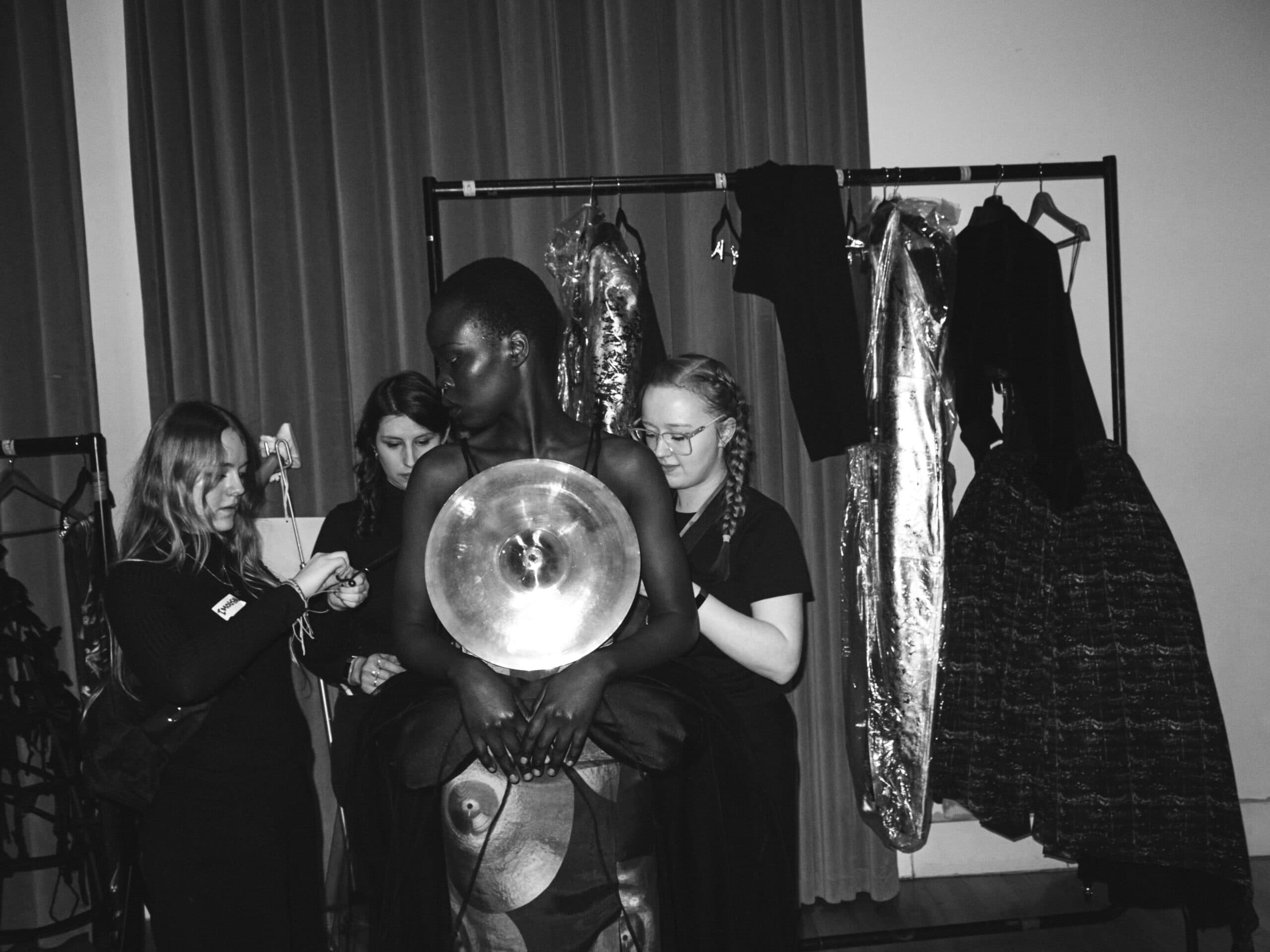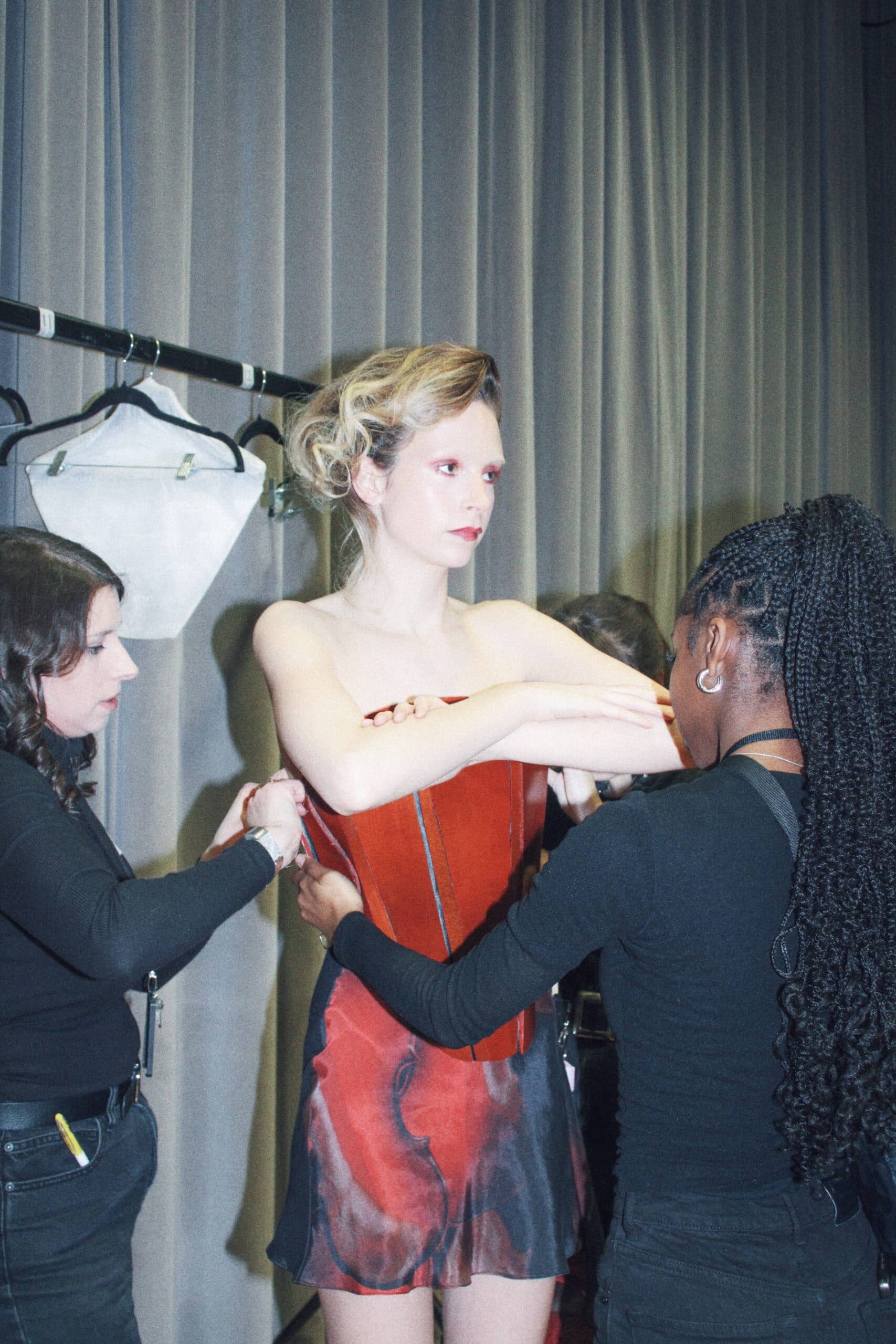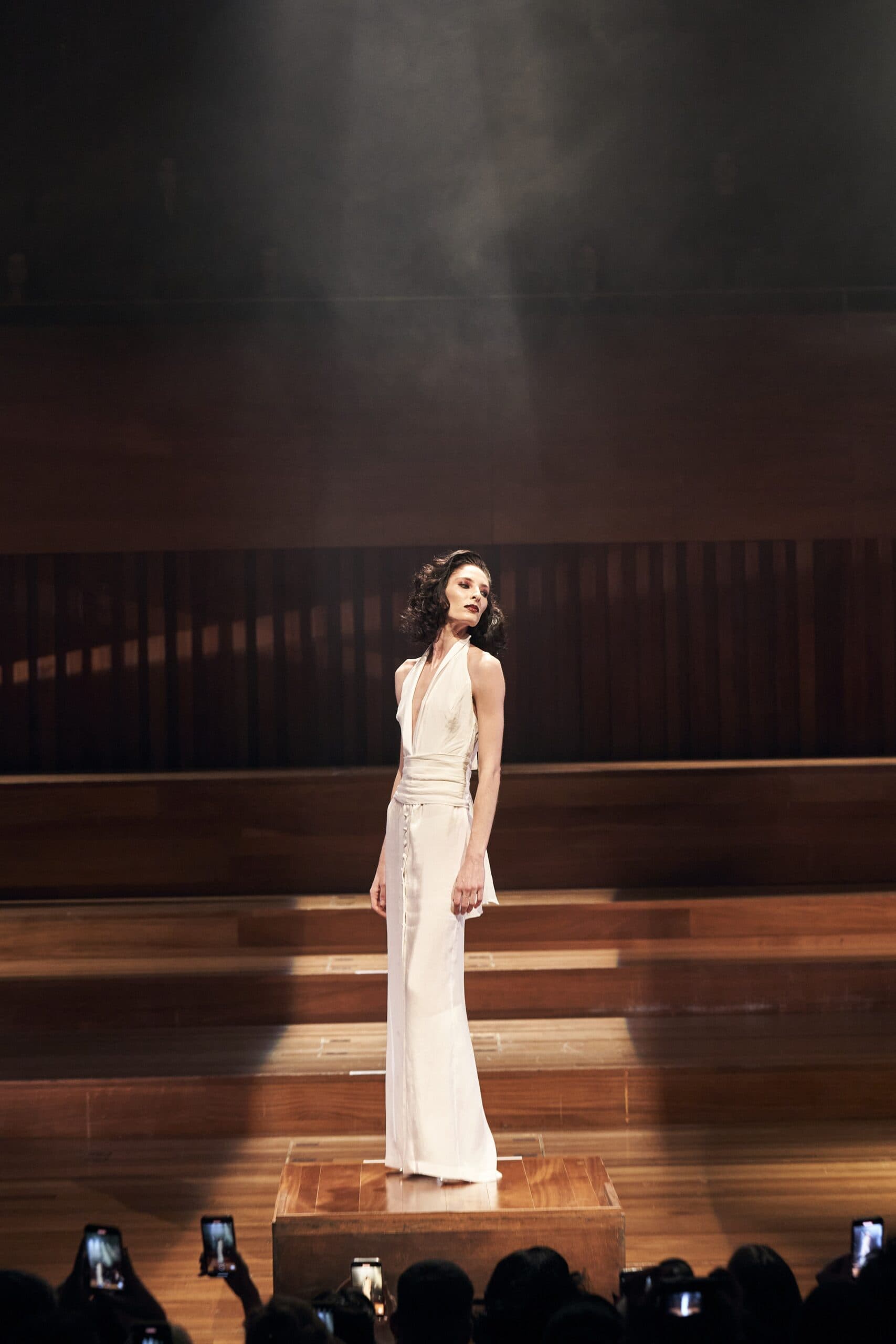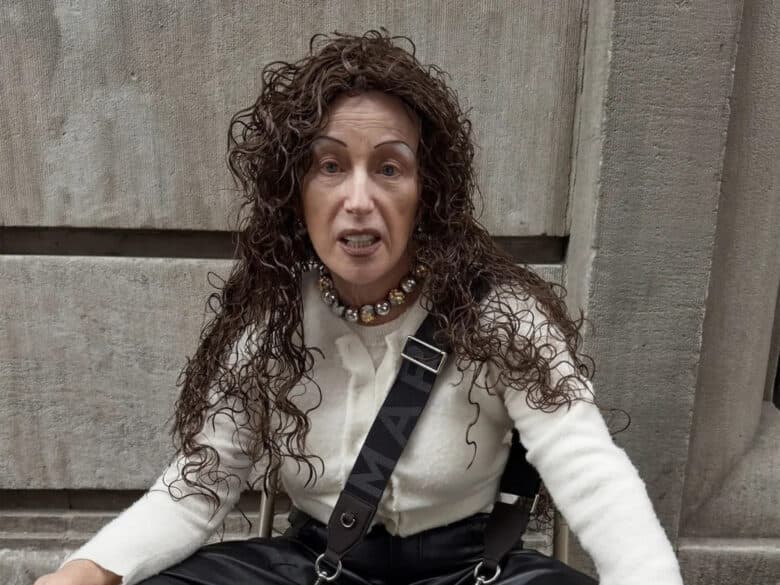Patrick McDowell is creating a new framework for fashion: “It completely flips the traditional business model on its head”

Patrick McDowell’s latest collection, ‘Orpheus’, may have launched a few weeks back, but the London-based designer behind the eponymous fashion brand is busy as ever with orders. Just last week, actress and singer Golda Rosheuvel showed off ‘Look 1’ from the collection at a Bridgerton press day. It was an apt outing for a garment made in collaboration with the Guildhall School of Music and Drama, which assisted with the creation of the pieces, as well as hosting their suitably theatrical launch, dubbed ‘Orpheus’ Ball’. The show itself featured musicians from the conservatoire, who shared the stage with models sporting designs inspired by the traditional dress of composers, as well as McDowell’s own musical past. The garments also gave a subtle nod to the collection’s ancient Greek name, the second Grecian-inspired title in the designer’s repertoire after his ‘Eurydice’ collection.
‘Orpheus’ is only the second collection to be launched within the McDowell brand’s new business framework — an industry first. Having created the brand in 2018, McDowell has made a name for himself through his commitment to sustainability, having used reclaimed and ethically-produced fabrics since the launch of his namesake brand. He’s even been lauded by Vogue’s editor-in-chief, Anna Wintour, for “striving to reinvent luxury through a sustainable mindset”. Now, the brand is evolving through their use of materials that are kinder to the planet, as well as made-to-order pieces, created with the help of artisans and cutters based locally in London — the brand’s hometown. Each garment is only available in a limited quality and comes with a complimentary refit for the buyer or a family member to avoid excess and extend the life of existing pieces.
Here, McDowell takes us behind the scenes of his latest business model and most recent collection.
HUNGER: So, Patrick, where did your career as a designer begin?
Patrick McDowell: I started when I was 13. I made a bag from a pair of jeans, and from then on I was really fascinated by this idea of creating something out of nothing and transforming old things into new things. I also grew up near Liverpool, so I always found it really fascinating how the women dress up and kind of peacock around the city. And then, fast forwarding through Central Saint Martins, I realised the need for change in the fashion industry when it comes to sustainability and decided to start my own brand.
HUNGER: Sustainability is obviously such a huge part of your work. What specifically was it that made you want to be a sustainable designer? Like, what really struck a chord with you?
PM: I think it was through working in the fashion industry and seeing that the business model that fashion was (and still is) running on was generating an enormous amount of waste. That, on a really simple level, didn’t make sense to me — and still doesn’t really. So I was always interested in designing amazing clothes but also kind of trying to redesign that system. I wanted to produce the things that people actually bought, rather than trying to grow the unit forever without actually knowing if anyone was ever going to buy any of them.
H: Is that why you make your clothes to order?
PM: Yeah, exactly. We have this business model where the pieces are pre-set in their quantities and issued in editions of between one of one and 50 of one. Each piece is numbered, the client’s name is stitched into it and it’s made to their measurements. So it completely flips the traditional fashion business model on its head because, from fast fashion all the way to luxury fashion, it’s usually based on perpetual growth. To create something that is luxury and sustainable, it was clear we needed to do something that limited the numbers and didn’t have any waste, and actually make things that fit and suit people. It creates something much more special and exclusive because we know exactly who has our pieces and we’re able to offer aftercare, such as re-design and repair.

H: How did sustainability come into your most recent collection, ‘Orpheus’?
PM: It’s multifaceted, really. There were amazing pieces in the show that were created from old instruments that were no longer playable, which we worked on with a set design student from Guildhall. And then we worked with the costume department at Guildhall to get materials that they were unable to use for projects and turned them into new pieces. Then we also have some partnerships with amazing family-led silk mills in Italy, like Taroni Silk, and Tencel, a low energy, low water-use, viscous material, which is setting a standard in the industry for best practice and is fully traceable from the tree all the way through to the finished garment. We also make everything here in London, so the carbon footprint of our pieces is much lower. And the crucial difference is that our business model is different and that means that our overall impact as a brand is much lower than most fashion brands.
H: The name of your collection, ‘Orpheus’, is also the name of a figure from ancient Greek mythology. What inspired you to dip into that realm?
PM: It was really important to me that the collection really spoke to the partnership and collaboration with Guildhall, so a lot of the inspiration around the collection was to do with music and the orchestra itself. With Guildhall being one of London’s oldest and most prestigious music schools, it felt appropriate that we would choose the demigod of music for the name.
H: You’re really big on being inclusive, especially when it comes to LGBT issues. In Ovid, the character of Orpheus is presented as queer. Was that anything to do with your decision to incorporate him into the collection, too?
PM: It’s interesting that you mention that actually because, as we move forward, we’re starting to look more at how the queer world was experienced in communities thousands of years ago through our designs. And I think a lot of queer people are drawn to mythology because it presents a more fluid version of sexuality and gender identity and, I mean, that’s very interesting to me.
H: Would you say that the ancient Greek aspect came into the designs themselves in the ‘Orpheus’ collection?
PM: Yeah, for sure. I think the whole thing referenced that. You know, the use of that gold foiling on the leather pieces was actually gilding — so the same technique as when people gild statues or plaster. We did the same thing by hand to give that effect. So the seams looked like, you know, the ceiling of an amazing building or something. Then there’s the statuesque silhouettes, very long and tall. And the colour palette — brown, gold, white, grey — I feel kind of related to the Classical world.

H: Some of the designs are quite androgynous. Can you tell me a bit about that?
PM: I think it’s part of my designer handwriting in general. I design pieces of clothing that work on many body types — and it speaks to our wider belief as a brand around creating pieces for anyone. Because of how we work, we’re able to create any of our pieces for any body type in any size. I believe that anyone can wear any piece of clothing. It’s a really important part of what I do. Whoever decides to put something on should be able to do that, and we’re able to create it for them in a way that makes them look good.
H: Was that idea reflected in your choice of models in the show?
PM: Yeah, for sure. I think it’s important that the brand represents its capabilities in the shows, too. As a queer person myself, I appreciate how important representation is. We’ve actually been voted one of the most inclusive designers by Vogue Business — not just in London but across all four fashion capitals. But aside from that, it comes from a place of wanting to create something beautiful, and I wouldn’t feel like I would be achieving that if all of our models looked exactly the same. That’s the most beautiful way to display perfection, right?
H: Which would you say are the standout designs for you in ‘Orpheus’?
PM: The tuba piece that was turned into a metal corset is quite special because I played brass instruments as a child. It was kind of amazing to be able to take a broken tuba and create fashion with it — it’s really a joy for me to see the brand evolving. My other favourite pieces are the all-white looks that were made from a really lovely Tencel linen fabric which has a really nice bounce. Both have cummerbunds and are really classic and simple — very statuesque. And of course there’s the pannier skirt which we stitched hundreds of vintage bow ties from Guildhall’s costume store onto. But all the pieces are so special because they’re all individual and linked to the narrative.
H: This collection is obviously very much in full swing, but what’s next for you?
PM: ‘Orpheus’ just came out, so that’s kind of having its moment now. There are lots of awards ceremonies and things happening, so the collection is being worn by different people. And, of course, there are orders coming in from clients. Then, looking forward to September Fashion Week, we’re working on creating a collection for that. Fashion moves very quickly. It’s really interesting for us, though — because of how we work, our collections feel more special and are smaller, so we’re able to do these deeper dives into different narratives and spend longer making everything. It’s really a joy to explore this alternative, more modern version of a fashion business.
- WriterScarlett Coughlan

